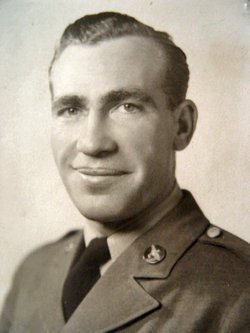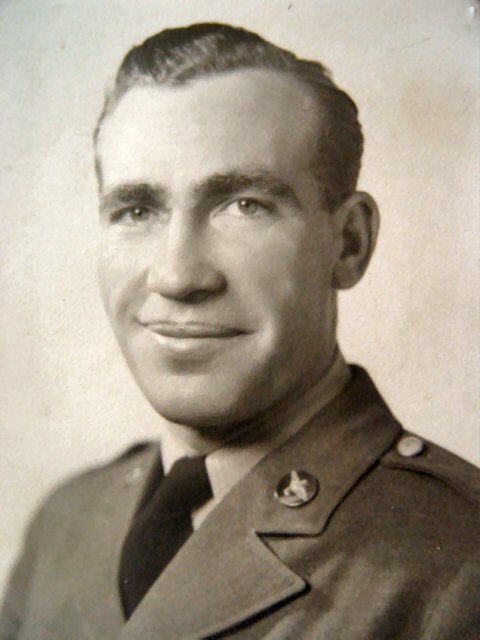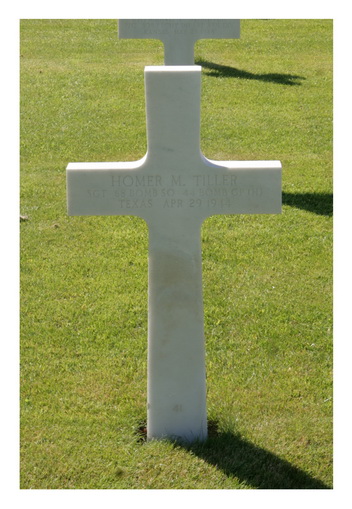Click here for his cenotaph memorial, located in Colorado City, Texas.
USAAF WORLD WAR II
Gunner Sgt. Homer M. Tiller KIA
Hometown: Colorado City, Texas
Squadron: 68th Sq. 44th Bomb Group
Awards: Air Medal, Purple Heart
Pilot 2nd/Lt. Glenn H. Sweigart
MACR #4472
Target: Berlin, Germany
Mission Date: 29-Apr-44
Serial Number: #41-29471
Aircraft Model B-24
Location: Germany
Cause: German fighter
Crew of 10 7KIA 3POW
Specific target was the underground railway in the heart of Berlin. Our formation of 21 aircraft encountered moderate to intense flak and from 30 to 50 enemy aircraft sustaining their attacks from Berlin back to Holland, most of this time unescorted. Three of our aircraft did not return. Squadron losses were as follows: one each by the 67th, 68th and 506th.
The pilot on the 68th Squadron aircraft lost on the 29th was 2nd Lt. Glenn H. Sweigart. The MACR states that at 1101 hours, aircraft #471 was hit by enemy aircraft, peeled off to the left, #3 engine was on fire and spreading to the fuselage. Two men bailed out before it went into a spin and then exploded. Mrs. Mary E. Turocy, widow of Lt. John W. Turocy, navigator on this airplane, sent this information "It was their eighth mission when their B-24 was hit by the German fighter and exploded. Two crew members were blown out with the debris and when John regained consciousness, he was falling through space. He jerked his ripcord and the shock pulled his shoes off. He threw his gun away, and tore up what papers he was carrying as he was descending. When he landed bare-footed in a little Germany town, the Villagers surrounded him with pitchforks until German soldiers came and dragged him off to jail, bleeding feet and all. He was in several POW camps, one of which was Stalag 13. "Being an officer, he was given the privilege of using their library and John took this opportunity to study theory – he played classical violin – and to occupy his mind, he translated from German to English copious notes. When John was liberated, he weighed just 110 pounds!
The pilot, Lt. Sweigart, added, "Our call was Smokey Blue Joe, X for X-ray. Somewhere over Germany we lost all the oil pressure on #3 engine and had to drop out of formation because the prop flattened out on us. I couldn't hold altitude or air speed. So we finally maintained altitude at 9500 feet and 105 mph, skidding sideways against the prop with near full rudder and still making a long arc, which we corrected occasionally by a circle. We had good cloud cover and limped along until, I think, it was Nuremburg where the clouds gave way. "Then all hell broke loose! I had told the crew that if anyone wanted to leave, they could jump at any time. I had two men I didn't know, replacing Gwin and Tony (Goodman). I told them if we got hit and lost intercom to go, cause I'd go if we got hit or went below 7500 feet. I believe that our radioman, Sgt LaVake, took off.
"When we got hit, it took the putt-putt right out of the side of the aircraft, and split the control pedestal wide open and knocked out all controls as well as the intercom. Our bombardier, Gil Roberts, was begging for us to all go as he would not go alone. Turocy showed me black and blue fingerprints on his shoulder where Gil was hanging onto him when we were hit. The explosion blew Turocy out the nose wheel and Gil into the front of the airplane and killed him. I was told about Gil's position at prisoner interrogation.
"McWhorter, my engineer, tried to get to the back of the plane to help the fellows in the back. He was blown off the catwalk by another hit, I think. Greene (co-pilot) then left, and I hung up my mike and earphones, looked at Greene's cigarettes and lighter – for some reason I left them, thinking he'd be back after them. "The aircraft crashed and burned after a long, slow, even half circle when anyone in it could have and should have bailed out. At interrogation, they kept asking me why I had only a six man crew, so I know that some of my men got out but they didn't live. Turocy, Greene and I were together. I saw who I thought was McWhorter lying in a field as I came down, and Gil Roberts was still in the plane. That makes five that I can account for. And they had pictures of Sgts. Nome and Tiller – that's seven. "I do know that I bailed out without my leg straps buckled and hung myself by the neck. When I tried to take the pressure off by swinging my feet into the shrouds, I skidded back and forth across the sky. I think that's why I survived because I could hear those 88 mms going off nearby all the way to the ground and couldn't see anything else in the sky but me for a target! "I came down in the middle of a plowed field and about 3,000 people. I spoke enough German to get myself into the hands of a little infantry corporal, who took me to his Captain and eventually to the airdrome.
"As far as the MACR account, it must be about another aircraft because we were at least an hour and a half out of formation and completely alone when we were shot down. Turocy, Greene and I were together in POW camps at Sagan, Nuremburg to Moosburg, until liberated."
The two men that Sweigart didn't know were Julius Naber and Harold Koehler. Naber was from the 66th Squadron and had flown 22 missions previously. Koehler had joined the 68th Squadron on 31 January 1944 with the Dyer crew. He had flown 15 prior missions.
#41-29471 Crew
2nd/Lt. Glenn H. Sweigart Pilot POW
2nd/Lt. Floyd H. Greene Jr. Co Pilot POW
2nd/Lt. John W. Turocy Navigator POW
1st/Lt. Gilman N. Roberts Bombardier KIA
S/Sgt. Lamer Mcwhorter Engineer KIA
S/Sgt. John W. Levake Radio Op. KIA
S/Sgt. Julius V. Naber Gunner KIA
Sgt. Homer M. Tiller Gunner KIA
Sgt. Homer M. Tiller Gunner KIA
S/Sgt. Harold F. Koehler Gunner KIA
Sgt. Albert A. Nome Gunner KIA
Sgt. Albert A. Nome Gunner KIA
Click here for his cenotaph memorial, located in Colorado City, Texas.
USAAF WORLD WAR II
Gunner Sgt. Homer M. Tiller KIA
Hometown: Colorado City, Texas
Squadron: 68th Sq. 44th Bomb Group
Awards: Air Medal, Purple Heart
Pilot 2nd/Lt. Glenn H. Sweigart
MACR #4472
Target: Berlin, Germany
Mission Date: 29-Apr-44
Serial Number: #41-29471
Aircraft Model B-24
Location: Germany
Cause: German fighter
Crew of 10 7KIA 3POW
Specific target was the underground railway in the heart of Berlin. Our formation of 21 aircraft encountered moderate to intense flak and from 30 to 50 enemy aircraft sustaining their attacks from Berlin back to Holland, most of this time unescorted. Three of our aircraft did not return. Squadron losses were as follows: one each by the 67th, 68th and 506th.
The pilot on the 68th Squadron aircraft lost on the 29th was 2nd Lt. Glenn H. Sweigart. The MACR states that at 1101 hours, aircraft #471 was hit by enemy aircraft, peeled off to the left, #3 engine was on fire and spreading to the fuselage. Two men bailed out before it went into a spin and then exploded. Mrs. Mary E. Turocy, widow of Lt. John W. Turocy, navigator on this airplane, sent this information "It was their eighth mission when their B-24 was hit by the German fighter and exploded. Two crew members were blown out with the debris and when John regained consciousness, he was falling through space. He jerked his ripcord and the shock pulled his shoes off. He threw his gun away, and tore up what papers he was carrying as he was descending. When he landed bare-footed in a little Germany town, the Villagers surrounded him with pitchforks until German soldiers came and dragged him off to jail, bleeding feet and all. He was in several POW camps, one of which was Stalag 13. "Being an officer, he was given the privilege of using their library and John took this opportunity to study theory – he played classical violin – and to occupy his mind, he translated from German to English copious notes. When John was liberated, he weighed just 110 pounds!
The pilot, Lt. Sweigart, added, "Our call was Smokey Blue Joe, X for X-ray. Somewhere over Germany we lost all the oil pressure on #3 engine and had to drop out of formation because the prop flattened out on us. I couldn't hold altitude or air speed. So we finally maintained altitude at 9500 feet and 105 mph, skidding sideways against the prop with near full rudder and still making a long arc, which we corrected occasionally by a circle. We had good cloud cover and limped along until, I think, it was Nuremburg where the clouds gave way. "Then all hell broke loose! I had told the crew that if anyone wanted to leave, they could jump at any time. I had two men I didn't know, replacing Gwin and Tony (Goodman). I told them if we got hit and lost intercom to go, cause I'd go if we got hit or went below 7500 feet. I believe that our radioman, Sgt LaVake, took off.
"When we got hit, it took the putt-putt right out of the side of the aircraft, and split the control pedestal wide open and knocked out all controls as well as the intercom. Our bombardier, Gil Roberts, was begging for us to all go as he would not go alone. Turocy showed me black and blue fingerprints on his shoulder where Gil was hanging onto him when we were hit. The explosion blew Turocy out the nose wheel and Gil into the front of the airplane and killed him. I was told about Gil's position at prisoner interrogation.
"McWhorter, my engineer, tried to get to the back of the plane to help the fellows in the back. He was blown off the catwalk by another hit, I think. Greene (co-pilot) then left, and I hung up my mike and earphones, looked at Greene's cigarettes and lighter – for some reason I left them, thinking he'd be back after them. "The aircraft crashed and burned after a long, slow, even half circle when anyone in it could have and should have bailed out. At interrogation, they kept asking me why I had only a six man crew, so I know that some of my men got out but they didn't live. Turocy, Greene and I were together. I saw who I thought was McWhorter lying in a field as I came down, and Gil Roberts was still in the plane. That makes five that I can account for. And they had pictures of Sgts. Nome and Tiller – that's seven. "I do know that I bailed out without my leg straps buckled and hung myself by the neck. When I tried to take the pressure off by swinging my feet into the shrouds, I skidded back and forth across the sky. I think that's why I survived because I could hear those 88 mms going off nearby all the way to the ground and couldn't see anything else in the sky but me for a target! "I came down in the middle of a plowed field and about 3,000 people. I spoke enough German to get myself into the hands of a little infantry corporal, who took me to his Captain and eventually to the airdrome.
"As far as the MACR account, it must be about another aircraft because we were at least an hour and a half out of formation and completely alone when we were shot down. Turocy, Greene and I were together in POW camps at Sagan, Nuremburg to Moosburg, until liberated."
The two men that Sweigart didn't know were Julius Naber and Harold Koehler. Naber was from the 66th Squadron and had flown 22 missions previously. Koehler had joined the 68th Squadron on 31 January 1944 with the Dyer crew. He had flown 15 prior missions.
#41-29471 Crew
2nd/Lt. Glenn H. Sweigart Pilot POW
2nd/Lt. Floyd H. Greene Jr. Co Pilot POW
2nd/Lt. John W. Turocy Navigator POW
1st/Lt. Gilman N. Roberts Bombardier KIA
S/Sgt. Lamer Mcwhorter Engineer KIA
S/Sgt. John W. Levake Radio Op. KIA
S/Sgt. Julius V. Naber Gunner KIA
Sgt. Homer M. Tiller Gunner KIA
Sgt. Homer M. Tiller Gunner KIA
S/Sgt. Harold F. Koehler Gunner KIA
Sgt. Albert A. Nome Gunner KIA
Sgt. Albert A. Nome Gunner KIA
Bio by: John Dowdy
Gravesite Details
Entered the service from Texas.
Family Members
-
![]()
Sadie Elizabeth Tiller Venus
1896–1944
-
![]()
Mamie Gertrude Tiller Boyd
1898–1995
-
![]()
Elzye Lee Tiller
1900–1968
-
![]()
Annie Mae Tiller Brown
1902–1983
-
![]()
Buck Elvie Tiller
1904–1951
-
![]()
Blanche L. O'Neal
1908–1986
-
![]()
SGT Homer Morris Tiller
1911–1944
-
![]()
John Ellis Tiller
1915–2012
-
![]()
Stella Irene "Skeeter" Tiller Tidwell
1919–2016
Sponsored by Ancestry
Advertisement
Advertisement


















